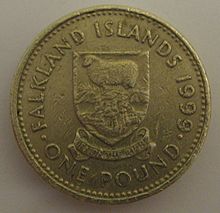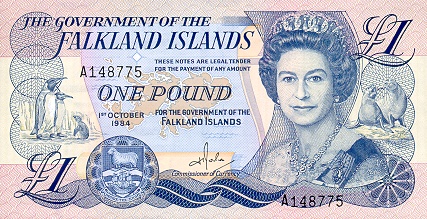|


The pound is the currency of the Falkland Islands, a British Overseas Territory in the South Atlantic Ocean. The symbol is the pound sign, £, or alternatively FK£, to distinguish it from other pound-denominated currencies. The ISO 4217 currency code is FKP.
The Falklands pound has always been pegged to the pound sterling at par and banknotes of both currencies are used interchangeably on the islands (although only notes issued by banks in the United Kingdom are generally accepted in Britain itself).
History
The pound was introduced following the reassertion of sovereignty in the Falklands Islands by the British in 1833. Initially, the British currency circulated, with the pound subdivided into 20 shillings, each of 12 pence. Specific issues of banknotes have been made for the Falkland Islands since 1899. In 1971, the pound was decimalised and subdivided into 100 pence. Coins have been minted specifically for the Falklands since 1974. During the earlier Argentine occupation, the peso circulated.
For a more general history of currency in the South Atlantic region, see The Sterling Currency in the South Atlantic and the Antarctic.
Coins
In 1974, ½, 1, 2, 5 and 10 pence coins were introduced. 50 pence coins were introduced in 1980, followed by 20 pence in 1982, 1 pound in 1987 and a circulating 2 pounds in 2004. The ½ penny coin was last issued in 1983 and was demonetised shortly after. Smaller versions of the 5p, 10p and 50p, corresponding to the current UK issues, were issued in 1998, replacing the larger versions (which for the 5p was eight years after its introduction in the UK). The introduction of the circulation £2 coin in 2004 was six years after the same coin was issued in the UK. All the coins have the same composition and size as the corresponding British coins.
Banknotes
Between 1899 and 1901, the government introduced notes for 5 and 10 shillings, 1 and 5 pounds. The 5 shilling notes were issued until 1916. In 1969, in preparation for decimalisation, the 10 shilling note was replaced by a 50 pence note. 10 pound notes were introduced in 1975, followed by 20 pounds in 1984 and 50 pounds in 1990. Banknotes in circulation are:
- 5 pounds (red)
- 10 pounds (green)
- 20 pounds (grey)
- 50 pounds (blue, green and red combination)
Falklands' banknotes feature the same images, differing only in their respective denominations and corresponding colours. On the front side, all notes contain a portrait of Queen Elizabeth II, the Falklands' coat of arms, a small map of the islands, and images of two of the islands' main animals, penguins and sea lions. On the back, notes feature pictures of Christ Church Cathedral in Stanley and Government House, the official residence of the Governor of the Falkland Islands.
The text on this page has been made available under the Creative Commons Attribution-ShareAlike License and Creative Commons Licenses
|
